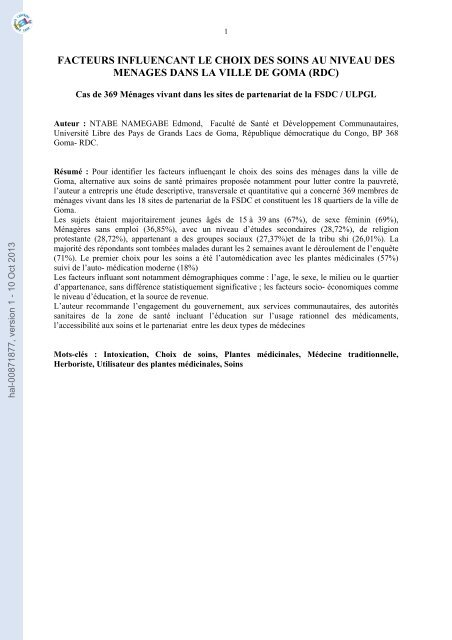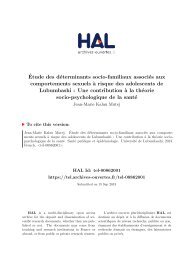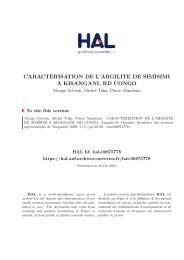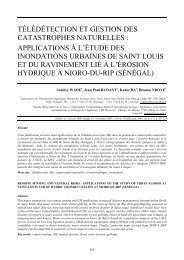FACTEURS INFLUENCANT LE CHOIX DES SOINS AU NIVEAU ...
FACTEURS INFLUENCANT LE CHOIX DES SOINS AU NIVEAU ...
FACTEURS INFLUENCANT LE CHOIX DES SOINS AU NIVEAU ...
You also want an ePaper? Increase the reach of your titles
YUMPU automatically turns print PDFs into web optimized ePapers that Google loves.
1<strong>FACTEURS</strong> <strong>INFLUENCANT</strong> <strong>LE</strong> <strong>CHOIX</strong> <strong>DES</strong> <strong>SOINS</strong> <strong>AU</strong> NIVE<strong>AU</strong> <strong>DES</strong>MENAGES DANS LA VIL<strong>LE</strong> DE GOMA (RDC)Cas de 369 Ménages vivant dans les sites de partenariat de la FSDC / ULPGLAuteur : NTABE NAMEGABE Edmond, Faculté de Santé et Développement Communautaires,Université Libre des Pays de Grands Lacs de Goma, République démocratique du Congo, BP 368Goma- RDC.hal-00871877, version 1 - 10 Oct 2013Résumé : Pour identifier les facteurs influençant le choix des soins des ménages dans la ville deGoma, alternative aux soins de santé primaires proposée notamment pour lutter contre la pauvreté,l’auteur a entrepris une étude descriptive, transversale et quantitative qui a concerné 369 membres deménages vivant dans les 18 sites de partenariat de la FSDC et constituent les 18 quartiers de la ville deGoma.Les sujets étaient majoritairement jeunes âgés de 15 à 39 ans (67%), de sexe féminin (69%),Ménagères sans emploi (36,85%), avec un niveau d’études secondaires (28,72%), de religionprotestante (28,72%), appartenant a des groupes sociaux (27,37%)et de la tribu shi (26,01%). Lamajorité des répondants sont tombées malades durant les 2 semaines avant le déroulement de l’enquête(71%). Le premier choix pour les soins a été l’automédication avec les plantes médicinales (57%)suivi de l’auto- médication moderne (18%)Les facteurs influant sont notamment démographiques comme : l’age, le sexe, le milieu ou le quartierd’appartenance, sans différence statistiquement significative ; les facteurs socio- économiques commele niveau d’éducation, et la source de revenue.L’auteur recommande l’engagement du gouvernement, aux services communautaires, des autoritéssanitaires de la zone de santé incluant l’éducation sur l’usage rationnel des médicaments,l’accessibilité aux soins et le partenariat entre les deux types de médecinesMots-clés : Intoxication, Choix de soins, Plantes médicinales, Médecine traditionnelle,Herboriste, Utilisateur des plantes médicinales, Soins
2ARTIC<strong>LE</strong>hal-00871877, version 1 - 10 Oct 2013INTRODUCTIONPartant de l’idée de (Young, 1981), une des meilleures voies d’examiner comment la médecinealternative est en interrelation, est d’examiner le point de vues des personnes qui l’utilisent. Il existeplusieurs sources de traitement moderne et traditionnel. Il est reconnu qu’il existe des voies majeuresincluant l’auto- méditation mais aussi le traitement dirigé par des personnes expérimentées 1 .Aujourd’hui l’usage des plantes médicinales prend une place prépondérante dans le choix de soinsdans certaines communautés dans le monde. Les abus sont fréquemment observés et se sont lespopulations qui en sont victimes.Selon l’Organisation des nations unies, 3 millions des personnes sont intoxiquées chaque année pardes plantes médicinales, inclus les produits industriels, les pesticides et les médicaments 2 .Bruneton, (1999), Rogers et Von Kanel, (1993) relatent qu’au USA et d’autres pays sud américains,les plantes médicinales sont fréquemment utilisées et les intoxications prennent la 4 e place. Les enfantsreprésentent 44% des cas les plus touchées 3 .En Afrique, 80% de la population consomme les plantes médicinales ; les femmes et les enfants ensont les premiers consommateurs.L’OMS (1981), a observée que lorsque les soins formels ne sont pas disponibles, la population turnevers les plantes médicinales. Dans la plupart des cas des soignants des la médecine moderne veulenttraiter la communauté, malheureusement ils se retrouvent dans des situations où la communauté a elleseule ne peut pas se payer les soins ; Dans une communauté pauvre, le manque de services sanitairesforce les populations a s’orienter vers les plantes médicinales ou de la médecine alternative. Leshommes veulent se diriger vers les services modernes, quand les femmes cherchent a s’orienter vers lamédecine alternative qui coûterait moins chère et plus socialement acceptable 4 .En République Démocratique du Congo, les plantes médicinales ont prit une importance dans lacommunauté ; selon Penge, Kambu et Okonda (1999), La situation de la RDC est difficile a cause dela dégradation des infrastructures sanitaires, qui ont favorisée l’accroissement des effectifs des tradipraticiensdans le pays. La médecine traditionnelle est utilisée par environ 60% de la population et lesintoxications dues a ces types de traitement sont fréquemment observées mais aucune étude n’a jamaisété conduite a ce sujet 5 .Dans la ville de Goma, la population préfère utiliser les plantes médicinales pour toutes les catégoriesdes maladies, comme premier choix. Ce la est dû au fait que ces populations les ont déjà expérimenté.Cette option est adoptée selon que l’on est à l’hôpital ou à la maison et fait que les usagers des plantesmédicinales augmententLe problème d’intoxication par les plantes médicinales semble être une situation générale, maisaucune mesure n’est prise par les intervenant en santé pour protéger la population. Au niveau del’hôpital ces pratiques créent des confusions entre les personnels soignant lors de la prise en charge.1 Young (1981), Medical choice in a Mexican village, Rutgers University press, Mexico. (p. 4, 10)2 European commission, International bank, UNDP, meeting on plan for reducing poverty and management of theenvironment, Amades publication, July 20023 Bruneton, J. (1999), Pharmacognosia, phytochemistry, medicinal plants, 3 rd edition, Lavoisier, PARIS (p. 22, 809)4 WHO (1981), “ Traditional medicine in health services development,” World health Organization regionaloffice for Africa, BRAZAVIL<strong>LE</strong>-CONGO5 Penge O., Kambu K., and Okonda (1999), The impact of traditional medicine in the health care in DRC, Flashmed-Monkole paper, cefacongo, DRC (Page 15, 17)
3Certains malades sont accompagnés par leurs familiers qui leurs administrent des médicaments a basedes plantes médicinales sans autorisation préalable des personnels soignants ; ce la entraîne uneconfusion dans l’évaluation de deux types de traitement ; soit des réactions compétitives dues a cesdeux types de médicaments et les complications qui sont difficiles a gérer. Les complications les pluscouramment observées sont : les insuffisances hépatiques, insuffisance rénale, gastrite corrosive,troubles respiratoires et cardiaques ou des complications aigues comme les diarrhées, vomissements etles troubles psychiques et neurologiques.Les croyances populaires au tour de l’usage de plantes médicinales et l’intoxication l’usage est unautre facteur qui crée de a confusion parmi les personnels soignant. L’une des croyances est qu’unefois intoxiquée, le malade ne devrait pas recevoir une injection si non il va directement mourirC’est tout au tour de ce dilemme que notre étude s’est intéressée pour déterminer les facteurs quipoussent les populations de la vile de Goma a s’orienter vers le choix des plantes médicinales commepremier choixLa question de recherche de cette étude était de savoir quels sont les facteurs influençant le choix dessoins des ménages dans la ville de GomaDe cette question, ces hypothèses ci- dessous ont été formulées :hal-00871877, version 1 - 10 Oct 20131. Les facteurs démographique, tels que l’age, le sexe et le quartier d’appartenance ainsi que laconnaissance, l’attitude, la perception et les pratiques influenceraient le choix de soins des ménagesdans la ville de GomaL’objectif de cette étude a été d’identifier les facteurs démographiques ainsi que la connaissance,l’attitude, la perception et les pratiques influençant le choix des soins des ménages dans la ville deGoma.MéthodesIl s’agit d’une étude descriptive, transversale et quantitative, menée du mois de décembre 2005 aumois de juin 2006 dans la ville de Goma. L’échantillon de 369 chefs de ménage a été déterminé enutilisant la formule de Fisher, sélectionnée a partir d’une population de 1600 ménages dans les 18quartiers de la ville de Goma.L’échantillonnage systématique combiné a l’échantillonnage stratifié et l’échantillonnage à plusieursstages a été utilisé pour déterminer les 1600 ménages dans tous les ménages de la ville de Goma. Ainsiles quartiers on été sélectionnés selon qu’ils se regroupent dans les quartiers a tendance ruraux, semiurbainsou urbains. De ces quartiers 3 ont été sélectionné aléatoirement ; puis de ces 3 quartiers 3cellules ont été sélectionnées aléatoirement et enfin 3 avenues représentant les mêmes. Ces de ces 3avenues qu’a été tirée la population d’étude de 1600 ou 369 ont été sélectionnéeLa technique d’interview couplée au questionnaire d’enquête a été utilisée.Les données ont été saisies et analysées en utilisant le logiciel SPSS et Excel puis transportées enWorld. Les données descriptives ont été analysées en utilisant les tables contenant des fréquences etdes pourcentages. Les tableaux ont été croisées afin de compares des les variables et de tester leshypothèses. Pour les variables nominales, le niveau de signification été testé en utilisant le chi- carréeToutes les valeurs p étaient calculées et a une valeur de p inférieure a 0,05 était considéréecomme statistiquement significative
4RésultatsLes sujets étaient majoritairement jeunes âgés de 15 à 39 ans (67%), de sexe féminin (69%),Ménagères sans emploi (36,85%), avec un niveau d’études secondaires (28,72%), de religionprotestante (28,72%), appartenant a des groupes sociaux (27,37%)et de la tribu shi (26,01%). Lamajorité des répondants sont tombées malades durant les 2 semaines avant le déroulement de l’enquête(71%). Le premier choix pour les soins a été l’automédication avec les plantes médicinales (57%)suivi de l’auto- médication moderne (18%)Choix de soinsLa détermination des choix des soins a été évaluée en identifiant tout d’abord les personnes qui sonttombés malades durant les 2 précédentes semaines. Il s’avère que 263 sur 369 soit 71% des répondantsétaient malades durant cette période. Comme il était question de déterminer leur premier choix lesrésultats suivants ont été trouvée comme résumé dans le graphique ci- dessous ; (Graphique 1)Graphique 1: Distribution de choix des soins (N=263)hal-00871877, version 1 - 10 Oct 2013Pourcentage60%50%40%30%20%10%0%0,40%5%12%157%Choix des premiers soins18%Relais commPas des soinstHopitalAuto- medication a base des plantesAuto medication moderneTradi - praticiens6%Facteurs Démographiques influençant le choix de soins dans les ménages de la vilede GomaL’étude a démontrée que la population étudiée était généralement jeune avec un age moyen de 30ansavec une déviation standard de 3,69, dominée par les femmes; le sex- ratio était de 3:1 en faveur desfemmes.Les facteurs age et sexe semblent influencer le choix de soins dans la ville de Goma. Les jeunespréfèrent plus utilisés les plantes médicinales (57,5%) que les vieillards (56,3%)La différence n’est pas statistiquement trop significative; P value >.05 (Voir tableau 1)
5Tableau 1: Choice of care by Age, Sex and Place of residence (N=263)DemographicfactorsCHWsHeathfacilityChoice of Care ( N= 263)NoTreatmentOff theCounterTxSelfHerbalTrad.HealerTotal(x 2 c &x 2 t)PvalueAge group% % % % % % Nb15- 49 0.4 12.6 4.8 18.2 57.5 6.5 24750 and above - 6.2 12.5 18.8 56.3 6.2 16Significance level: .05SexFemale 0.5 11 6.5 17 57 8 183Male - 14 2 21 59 4 802.61312.591(Df=5)4.30812.5910.8190.506hal-00871877, version 1 - 10 Oct 2013Significance level: .05ResidencePeri Urban - 15 1 8.6 71.6 3.7 81Rural 1 6 6 13 62 12 94Urban - 16 8 33 40 3 88Significance level: .05(Df=5)39.94818.307(Df=10)Connaissance, attitude, perception et pratiques influençant le choix des soins desménages dans le ville de Goma4.5.2 Knowledge and choice of care0.00This section deal with the response of people on the knowledge of herbal medicine or not andthe list name of these medicinal plants on concerning name, side effects and intervention ifsame case occur in the householdThe findings showed those respondents haven’t knowledge on medicinal plants. About 100respondent on the 170 interviewed said they have knowledge on medicinal plants but whenthe number of those who don’t list any medicinal plant show a high proportion (45.2%)compared to those who list 1 or more than 9 medicinal plantsThe knowledge may not influence the choice of care of respondents (See table 8)4.5.3 Attitude of respondent to health personnel and choice of careThis section concerns the attitude that the respondents exhibit to the health personnel whenthey observe that their patient could go through others treatments’ alternatives but the healthpersonnel try to convince them
7Traditional medicine creates an interest in the populations at all level because of their sociocultural background.From our research, this situation is explained by the fact that it's the woman who produces themajority of household income; secondarily by the fact that women seek treatment earlier thanmen. The men minimize the effect of disease and seek treatment later.It can be concluded that the older respondents seek treatment earlier the younger. Thesituation of Goma could here been influenced by the psycho social situation of respondents. Inmajor quarters the phenomenon of witchcraft was observed; people are accused to be witches.Then the tendency of the elder in the answering was given with reserve. This could explainthe variation in responses by age5.5 Skills, Knowledge, attitude and Perception the household’s choice ofcarehal-00871877, version 1 - 10 Oct 20135.5.1 Skills and choice of careThe respondent were skilled in medicinal plants; the family discussion influence family’smembers to choose first the herbal treatment (91.7%). Their source of information comesfrom relatives (24.3%) with an experience time of 1 to 5 years (64.3%)The skill of Goma people is explained by the ecologic system that provider this city thenational park is around 15 km to Goma city. This national park is the extension of theequatorial forest which has significant biodiversity species of flowering medicinal plants. Thecommunity has accessibility to this natural reserve which is an opportunity in performingskills and knowledge.This community is knowledgeable as show the result of the names of medicinal plants list bythem. They could list 1 to 4 medicinal plants.5.5.2 Attitude to health personnel and choice of careThe findings illustrate that the respondents’ attitude was the observation (48.3%), or referringtheir patient to the traditional medicine (24%). The attitude of family is a result of what theyobserved during the care process at the health facility level5.5.4 Perception and choice of careRespondents who said that traditional medicine is used for prestige of use natural tended toseek first self herbal treatment (50%), followed by those who said that it’s procuringconfidence (48.8%).The respondents who said that modern medicine is good sought first self herbal treatment(43.4%) when who said that modern medicine is bad tended not do5.5.5 Practice and choice of careThe findings showed that the decision making on the choice of care may not influence thechoice of care. For those who said that they were visitors in the household were sought firstself herbal treatment (46.7%), yetVisitors were the main actor on the decision making on choice of care
8Chap 6: CONCLUSIONS AND RECOMMENDATIONSThis chapter presents summary of the key findings and recommendations based on thefindings of the study.hal-00871877, version 1 - 10 Oct 20136.1 ConclusionChoice of care was observed in Goma city. The self herbal treatment was the most commonalternative treatment (57%)Differences on demographic, socio- economic, cultural and health factors account for a largepart on the choice of care: The age, sex, education level, main source of income, religion,group membership were associated with the increased self- herbal medicationThe male young with a lower education level, lower source of income protestant or catholic asreligion from women/ men group membership tended to use self herbal treatment as firstchoice to cure diseases in Goma city; Advice from the health personnel appears to be a majorhealth factor that orients the choice of care.About skills, knowledge, attitude, perception and practices: The respondents were skilled inmedicinal plants, they were knowledgeable with a positive attitude to health personnel andgood perception on both medicines and good practices.Family discussions and relatives play a role in the use of self herbal medicine6.2 Recommendations6.2.1 Recommendations for PolicyCertain policy and practice implications arise:1. Public messages need to focus aggressively on improving early recognition of severesigns of disease at home and improving promptness of treatment seeking2. Quality of modern care providers and modern care must be improved in all sectors,private, NGO and Government3. Patient adherence with modern care at home must be simplified and reinforced.6.2.2 Recommendations for further research1. Further studies to assess drug use model and health care needs of the population areurgently required. The Alternative medicine is an area that definitely merits moreresearch, and the use of it will hopefully continue to grow therefore offering the publicmore choices regarding what's most important in life, your health.2. In doing future research it would be better to include a more even number of males andfemales in equal proportion.
10hal-00871877, version 1 - 10 Oct 20138.2 Articles13. Tarly Felhaber (1999), South African primary health care handbook:Combining western and traditional practices, Formsxpress, Retreat, CapeTown, South Africa.14. Tony swain (1972), Plants in the development of modern medicine, HarvardUniversity press, Cambridge, Massachusetts, USA15. Verdcourt B and Trump EC (1969), Common poisons plants of East Africa,Collin edition, GREAT BRITAIN (p. 9 to 17)16. Watt, J. M. Breyer-Brardwijk M.G. (1962), The medicinal and poisonousplants of southern and Eastern Africa, 2 nd edition, Edinburgh, London E&SLivingston ltd., GREAT BRITAIN.17. Young (1981), Medical choice in a Mexican village, Rutgers University press,Mexico. (p. 4, 10)18. Akerele, Olyiwola (1984), “WHO’s Traditional medicine program: Progressand perspectives”, World organization chronicle, 38(2) (p. 76 to 81)19. American Red Cross (1979), “Standard first aid and personal safety”, 2 ndedition American red cross, USA20. Arnold Th., Wet BC. (1993), “Plants of southern Africa: Names anddistribution”, memoirs of the botanical survey of South Africa, University ofnatal press, SOUTH AFRICA21. Bannerman, Robert H. (1983), “The role of traditional medicine in primaryhealth care” Traditional medicine and health coverage, World HealthOrganization, GENEVA. (p.318-327)22. Bouzidi A., Mahdeb N., and Allouche (2002), “Toxicological information”,Toxicological Center of Tunisia publication article volume 18 No 2 (p.1- 33)23. Diallo Drissa et al, (2002), “From the traditional knowledge to traditionalimproving drugs: Mali experience on Entada africana case”, Department oftraditional medicine in MALI, CEAD publication, MALI. (p. 1 to 19)24. Diallo Drissa, And Paulsen, B. (2000). “Pharmaceutical research andtraditional practitioners (healers and herbalists) in Mali”, University of Oslo,SUM press, MALI (p. 133, 143)25. Dyson A., Ashwell A, Loeedolff J., « Indigenous healing plants of the herb andfragrance gardens », National botanic Institute, SOUTH AFRICA.26. Growing of the agency for the social development (1999), « Health Center, awave for poor ». Review N°00, MALI27. Jean Pierre Olivier de Sardan (1999), « Anthropologia of health » Bulletin N°17 APAD, MALI28. Jeffrey Roger (1982), “Policies toward indigenous healers in independentIndia. Social science and medicine”, Vol. 16, WHO- GENEVA (p.1835- 1841)29. Jilek, Wolfgang G. (1985), « Traditional medicine and primary health care inPapua new Guinea », University of Papua New Guinea press, GUINEA30. Koumare, M. (1978), “Malian experience in the traditional research”, INRPMTBamako, MALI.
11hal-00871877, version 1 - 10 Oct 201331. Koumare, M. (1989), “Experience of traditional medicine in the countriesunder WHO regions”, First meeting of WHO Center collaborators ontraditional medicine of African region, Niamey”, WHO Regional office OMS,BRAZAVIL<strong>LE</strong>.32. Lee, Rance PL (1982), “Chinese and Western medical care in China’s Ruralcommunes”, World health forum, 3(3), WHO- GENEVA (p.301-306)33. Malgras. D. (1992), « Trees and healer’s small shrub of Mali bushes »,Karthala edition, PARIS34. Malick Traore (2002), “Resort to traditional African pharmacopoeia in the newmillennium”, Case of herbal women of BAMAKO, CEAD publication, MALI.35. Malick Traore, Niakate B. and the NGO ASIL Bamako (2001), « Study onfeasibility of the project on organization and training of herbal women inBamako district », CEAD publication, MALI36. Neumann (1982), A.K. and Laura, P., “Ethno-medicine and biomedicinelinking, Social science and Medicine”, Volume 10, WHO- GENEVA37. Olivier. B. (1960), « Medical plants in Nigeria », Nigerian college arts,sciences and technology publication, NIGERIA.38. Oswald, I.H. (1983), “Are traditional healers the solution to the failures ofprimary health care in Rural Nepal, in social science and medicine?” Volume17, No. 5, WHO, GENEVA39. Penge O., Kambu K., and Okonda (1999), The impact of traditional medicinein the health care in DRC, Flashmed-Monkole paper, cefacongo, DRC (Page15, 17)40. Robitaille, Hardy, and Davy (2001), Participation of Canada to the decade oftraditional medicine in Africa, “IDRC Bulletin publication, November, 2001”,Canada (p.1 to 8)41. Tan, Michael M., Querulin Mila, and RILLORTA, TITA (1988), “Theintegration of traditional medicine among community based health programs inPhilippines”, Journal of tropical pediatrics, volume 34, WHO-GENEVA42. USAID (1979) “ reaching the rural poor: Indigenous Health practitioners arethere already,” AID program evaluation discussion paper No. 1., WashingtonD.C., USA43. WHO (1978), “The promotion and Development of traditional medicine”,technical report series 622, World organization GENEVA44. WHO (1981), “ Traditional medicine in health services development,” Worldhealth Organization regional office for Africa, BRAZAVIL<strong>LE</strong>-CONGO45. Wilburg Hoff, Dr. PH and Gerri Shapiro, “Traditional Healers as communityhealth workers”, A review of projects using traditional healers as communityhealth workers”, WHO, SHS/ DHS/ 91.646. Lule, Allwright (2003), “The new public/ Private mix in health: Exploring thechanging landscape”, Alliance for health policy and systems research Geneva(p. 137- 140)
12hal-00871877, version 1 - 10 Oct 20138.3 Grey literatures47. BUFIGI, H.C., Traditional medicine, Care by trees, inédit, RDC, (Page72)48. Douaré, I. (1991), Contribution to the clinical study of’ Entada africana in theviral hepatitis, Thesis of medicine, Bamako, Mali. (Unpublished)49. Hundi (2005), Census of Goma population, Town council report, DR Congo(Unpublished)50. Kayungura G. (2001), Assessment on factors determining the health status of alow income community in BUJOVU area in DR Congo, Thesis report, TICH /KISUMU-KENYA (Unpublished) (p. 11 to 20)51. Mabiala Uwizeye Olivier (2004), Ethno botanic survey of plants used againstpoisoning in Goma, memory IFSDC/ ULPGL Goma, DR CONGO(Unpublished) (p. 4 to 63)52. Moussa Mariko (1989), Study on « Terenifou » activity, tree and leaf and thetree of pteleopsis suberosa ENGL and DIELS (Combretaceae) in the treatmentof gastro intestinal ulcer, thesis, National school of medicine and pharmacy,MALI. (Unpublished)53. Oumar Camara and Adama Mallé, « Contribution on a survey on traditionalhealers in charge on motor handicap. » Memory, Promotion 78-82 NationalInstitute of Arts (INA), MALI (Unpublished)54. Shankar (2003) “A Survey of Drug Use Patterns in Western Nepal”, BioMedCentral Family Practice 2002, 355. Traore Gouansegué, Memory « Remarque on some interest plants sells onBamako market » l’ENSUP. 75-76, MALI (Unpublished)8.4 International meeting:8.5. Internet56. European commission, International bank, UNDP, meeting on plan forreducing poverty and management of the environment, Amades publication,July 200257. http://minilien.com/ ?93T1MjQOzI58. http://www.amades.net59. http://www.cefacongo.org/papers/Flashmed-1999.pdf60. http://www.ichem.org/61. http://www.idrc.ca/fr/ev-70591-201-DO_TOPIC.html62. http://www.insipq.qc.ca/bulletin/informationtoxicologique/articles/vol18No2Tableaux1-2-3.pdf63. http://www.prometra.org64. http://www.psythere.free.com65. http://www.socialresearchmethods.net/kb/random.htm66. http://www.unep.org67. media@idrc.ca
1368. USAID: Democratic Republic of the Congo (DRC)69. http://www.biomedcentral.comhal-00871877, version 1 - 10 Oct 2013










